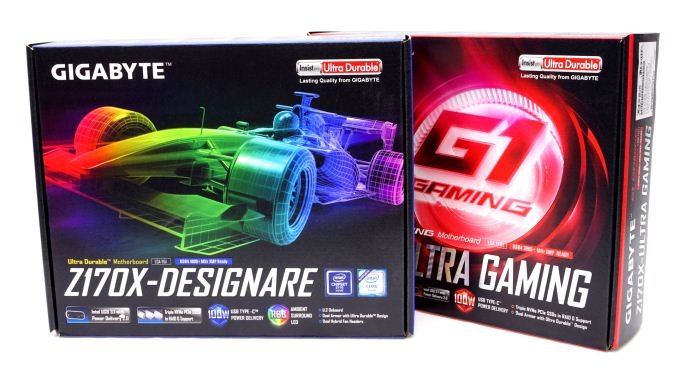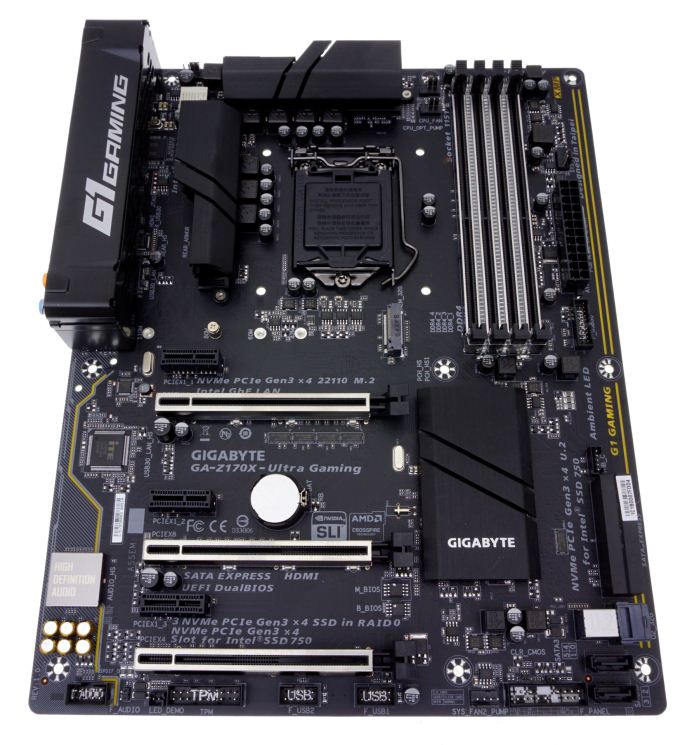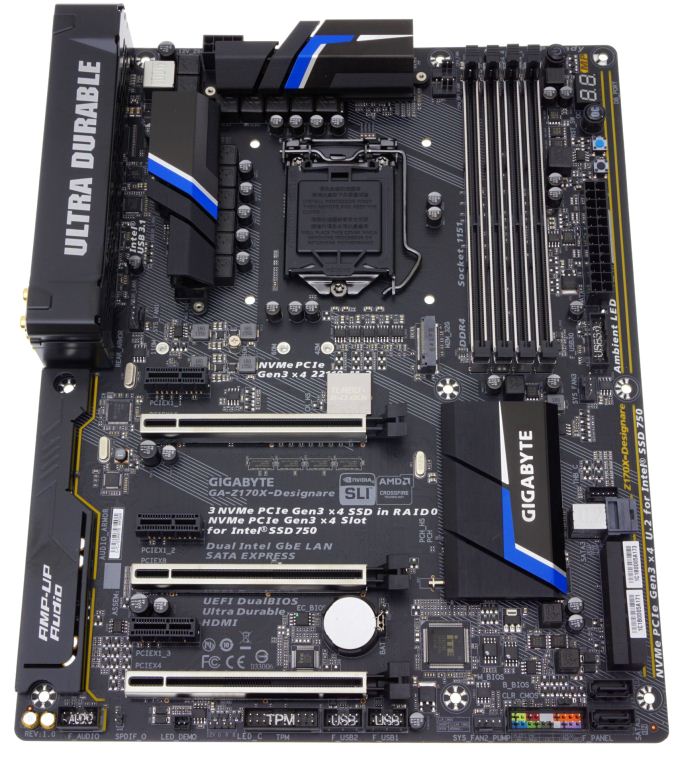The GIGABYTE Z170X-Ultra Gaming & Z170X-Designare Motherboard Review
by E. Fylladitakis on December 28, 2016 10:00 AM EST
GIGABYTE is the manufacturer with perhaps the richest selection currently available. Counting only the motherboards based on the Intel Z170 chipset, the company is currently offering 31 different models. We already had reviews of the top gaming model of the series, the $500 Z170X-Gaming G1, as well as their one of their first attempts to integrate Thunderbolt 3 with the Z170X-UD5 TH.
In this review we are having a look at the GA-Z170X-Ultra Gaming and the GA-Z170X-Designare, two boards that are similar (but not quite the same) with the Z170X-UD5 TH, featuring Thunderbolt 3 plus U.2 support. The GA-Z170X-Ultra Gaming currently retails for $156, while the more feature-packed GA-Z170X-Designare brings the price up to $220. We will examine their features, the differences and the performance in the following pages of this review.
Other AnandTech Reviews for Intel’s 6th Generation CPUs and 100-Series Motherboards
Skylake-K Review: Core i7-6700K and Core i5-6600K - CPU Review
Comparison between the i7-6700K and i7-2600K in Bench - CPU Comparison
Overclocking Performance Mini-Test to 4.8 GHz - Overclocking
Skylake Architecture Analysis - Microarchitecture
Z170 Chipset Analysis and 55+ Motherboards - Motherboard Overview
Discrete Graphics: An Update for Z170 Motherboards - PCIe Firmware Update
100-Series and C232/C236 Motherboard Reviews:
($500) The GIGABYTE Z170X-Gaming G1 Review
($500) The ASUS Maximus VIII Extreme Review
($370) The GIGABYTE Server MW31-SP0 Review (C236)
($310) The GIGABYTE Z170X-Extreme ECC Review (C236)
($250) The ASUS Maximus VIII Impact Review
($240) The ASRock Z170 Extreme7+ Review
($230) The MSI Z170 Gaming M7 Review
($220) The GIGABYTE Z170X-Designare (this review)
($208) The GIGABYTE Z170-UD5 TH Review
($165) The ASUS Z170-A Review
($156) The GIGABYTE Z170X-Ultra Gaming (this review)
($143) The ASRock E3V5 Gaming Review (C232)
($130) The MSI Z170A SLI PLUS Review
($125) The Supermicro C7H170-M Review
To read specifically about the Z170 chip/platform and the specifications therein, our deep dive into what it is can be found at this link.
Gigabyte GA-Z170X-Ultra Gaming Overview ($156)
The GA-Z170X-Ultra Gaming is Gigabyte's attempt to offer a gaming motherboard with U.2 support with a very reasonable price tag. Its current selling price of $156 is cheaper than expected for a quality gaming motherboard, lower even than Gigabyte's popular GA-Z170X-Gaming 7 model ($180) that has no U.2 support. It is important to note that despite recent innovations in the motherboard space, such as slot protection, the lower cost over the Gaming 7 does bring some compromises in extra controller support.
The GA-Z170X-Ultra Gaming has one U.2 connector, one M.2 PCIe 3.0 x4 slot, two SATA Express connectors and a total of six SATA 6Gb/s connectors. The one Intel I219-V network controller is paired with the Realtek ALC892 audio codec, which is surprising to see on a gaming motherboard (normally we see the ALC1150, or at a pinch, the ALC898). We expected the downgrade from the expensive Creative Core3D audio chip, and on the networking the decision for Intel is interesting given GIGABYTE's close relationship with Rivet Network's Killer team, so we had expected to see a single Killer E2400/E2500 network controller. A TPM header is present, as well as a header for an add-in Thunderbolt card, but there is no COM header on the GA-Z170X-Ultra Gaming (compared to the more expensive Gaming 7).
The sharing of bandwidth between the two PCIe x16 slots is typical, meaning that the top one will operate in x16 mode if a card is not installed in the second, or in in x8 mode if cards are installed in both of them. Despite the Z170 chipset having 20 PCIe lanes to use, there is some sharing going on here. The PCIe x4 slot shares its bandwidth with the SATA 0/1 connectors, so the SATA connectors will be disabled if a PCIe x4 device is installed there. Similarly, the U.2 slot shares its bandwidth with the SATA 2/3 connectors and the M.2 slot with the SATA 4/5 connectors. If you want to install a PCIe x4 device, a U.2 drive and a M.2 drive at the same time, the SATA connectors will all be inoperable. A PCIe x2 or slower device will not disable the SATA 0/1 connectors.
Gigabyte GA-Z170X-Designare Overview ($220)
Unlike its cheaper sibling, the GA-Z170X-Designare does not have a very specific target group. It seems as if GIGABYTE is trying to promote the board towards designers and engineers, or generally users that require the use of a professional graphics adapter. These cards hardly require a specialized motherboard though, and the GA-Z170X-Designare comes with many features that would be of general rather than targeted use. As such, the motherboard feels as an attempt to satiate engineers and professionals who entertain building a hybrid between a workstation and a gaming PC, or gamers who need something more feature-packed than the GA-Z170X-Ultra Gaming and can afford to pay the more premium price for it ($220 at the time of this review).
Much like the GA-Z170X-Ultra Gaming, the primary selling point of the GA-Z170X-Designare is that it can support U.2 drives. It only has one U.2 physical connector but, with the use of proper adapters, it can support up to three U.2 drives at once. It has two SATA Express connectors and a total of six SATA 6Gb/s connectors. Gigabyte installed dual LAN on this model, with two Intel network controllers present (I219-V + I211-AT). The network interfaces are supported by the cFosSpeed software. The audio codec is the Realtek ALC1150, which may not be equivalent to solutions coming from Creative, but it certainly is a very good product and a notable improvement over the ALC892/ALC898. Once again, TPM and Thunderbolt card headers are present, as well as an extra header for optional RGB LED strips. It is interesting to note that there is no COM header, and that can be a serious omission on a motherboard that is aimed towards professionals, especially engineers, however we rarely see it on non-IPC motherboards at this price. Last but not least, the GA-Z170X-Designare features GIGABYTE's Turbo B-Clock IC, a chip that allows for, in theory, better BCLK overclocking.
Exactly like its sibling, the GA-Z170X-Designare shares bandwidth between the two PCIe x16 slots, meaning that the top will operate in x16 mode if a card is not installed in the second slot, or in x8 mode if cards are installed in both of them. Also like with the GA-Z170X-Ultra Gaming, the GA-Z170X-Designare implements the same chipset (Intel Z170), which has 20 PCIe lanes. These 20 lanes are not enough to cover every feature of the motherboard, meaning that sharing was once again inevitable. The PCIe x4 slot shares its bandwidth with the SATA 0/1 connectors, so the SATA connectors will be disabled if a PCIe x4 device is installed there. Similarly, the U.2 slot shares its bandwidth with the SATA 2/3 connectors and the M.2 slot with the SATA 4/5 connectors. If you want to install a PCIe x4 device, a U.2 drive and an M.2 drive at the same time, the SATA connectors will all be inoperable. A PCIe x2 or slower device will not disable the SATA 0/1 connectors.
| Motherboard Comparison | ||
| GIGABYTE Z170X-Designare | ||
| Socket | LGA1151 | LGA1151 |
| MSRP at Review | $220 | $143 |
| DRAM | 4 x DDR4 | 4 x DDR4 |
| PCIe Layout | x8/x8 | x16 |
| BIOS Version Tested | F20 | 1.11 |
| MCT Enabled Automatically? | Yes | No |
| USB 3.1 (10 Gbps) | Intel Alpine Ridge | None |
| M.2 Slots | 1 x PCIe 3.0 x4 | None |
| U.2 Ports | 1 x PCIe 3.0 x4 | No |
| Network Controller | 1 x Intel I219-V 1 x Intel I211-AT |
1 x Intel I219-V |
| Audio Controller | Realtek ALC1150 | Realtek ALC1150 |
| HDMI 2.0 | No | No |












28 Comments
View All Comments
sweeper765 - Wednesday, December 28, 2016 - link
"If you want to install a PCIe x4 device, a U.2 drive and a M.2 drive at the same time, the SATA connectors will all be inoperable."I hope that will change with Z270, at least allow a full speed M.2 drive and all sata ports at the
same time.
Otherwise i feel we are moving backwards with these chipsets. Severe lane limitations, fewer and fewer rear usb ports, dual network adapters only on selected few (and expensive) motherboards.
BenJeremy - Wednesday, December 28, 2016 - link
Strange. I have the Gigabyte Z170X Gaming 5, and I have both M.2 slots used (RAID-0 nvme with 2 Plextor M8pe sticks), and I still had the use of my SATA slots - though the manual implied I would not.shabby - Wednesday, December 28, 2016 - link
Whats next... please remove 2 dimm's if you want to use sli/crossfire? This lane limitation is annoying.Duncan Macdonald - Wednesday, December 28, 2016 - link
Agreed - even for non-SLI use there are not enough PCIe lanes - 1 high end graphics card uses 16 lanes leaving 4 lanes for everything else. At a minimum a Z170 motherboard should have a setting that just uses 8 lanes for the graphics card and uses the remaining lanes to allow all the motherboard features to work at the same time.DanNeely - Wednesday, December 28, 2016 - link
The 16 lanes from the CPU are independent of the up to 20 lanes from the southbridge. I say "up to 20" because the 20 available high speed io ports that can be used for PCIe are shared with the ones used for sata and ethernet (the later is a mostly nominal factor though since a non-Intel NIC would need a port as a PCIe lane). Effectively this means you've got 13 PCIe lanes left from the chipset to share out among secondary PCIe slots, m.2, u.2, and SATAe ports. Theoretically another 4 could be used up for more USB3 ports; but in practice USB3 hub chips are cheaper than PCIe muxes so mobo makers will use the former to keep PCIe lanes free.http://images.anandtech.com/doci/9485/PCH%20Alloca...
Kraszmyl - Thursday, December 29, 2016 - link
They can add all the lanes they want to the pch and its still pointless. Those 30 lanes share a 4 lane highway back to the cpu, ram, and gpu.DanNeely - Wednesday, December 28, 2016 - link
The 200 series chipsets all offer 30 highspeed io lanes up from 26 or 22 on 100 series ones. The extra 4 will definitely help with this sort of thing on high end boards, but it's mid/low end ones that will benefit the most. Especially since they're the least likely to get any sort of PCI MUX chips to increase the effective number of lanes.The situation there should be improved significantly vs current generation mobos too, PLX chips almost entirely disappeared from consumer boards when the company making them was bought out by a company that wanted to cash in on high end server parts by cranking the cost from $20 to $80ish. The ASM1480 8:16 lane switch shows that at least one company saw an opening to design and sell a much more affordable product (these boards are nowhere near pricey enough to support an $80 component). For the sake of keeping prices competitive, hopefully Asmedia isn't the only company entering the market in the present/near future.
toobluesc - Wednesday, December 28, 2016 - link
Both motherboards have USB Type-C 100W power delivery built-in in and it wasn't even mentioned. Such a rare feature! I would love to charge my laptop from my desktop and skip having to buy another power brick.Any plans for an article testing the output and compatibility of USB Type-C Power Delivery?
Tchamber - Wednesday, December 28, 2016 - link
toolbluescConclusion page, 1st paragraph, last sentence.
"That being said, some of them are nice and fast, if your wallet is deep enough. Both boards also offer USB 3.1 via Intel's Alpine Ridge controller, and claim so support Power Delivery 2.0 up to 100W (unfortunately we don't have the hardware to test this).
May not be what you wanted, but it was mentioned.
MaidoMaido - Wednesday, December 28, 2016 - link
Why is it taking so long for desktop motherboard manufacturers to make their USB 3.1 Type C ports compatible with TB3 and DisplayPort?Nice to see the "Ultra Gaming" model has it, but it's still relatively uncommon. Are the royalties too expensive or something? I would have imagined nearly every Type C port being TB3 & DisplayPort compatible by now.